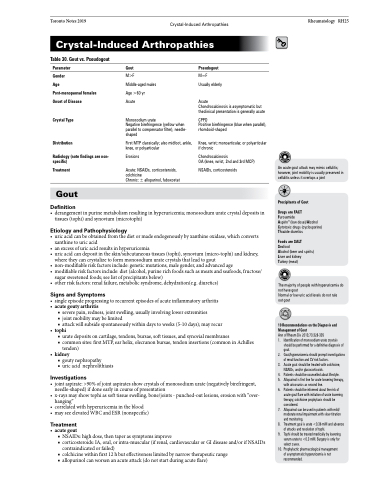Page 1311 - TNFlipTest
P. 1311
Toronto Notes 2019 Crystal-Induced Arthropathies Crystal-Induced Arthropathies
Rheumatology RH25
Table 30. Gout vs. Pseudogout
Parameter
Gender
Age
Post-menopausal females Onset of Disease
Crystal Type
Distribution
Radiology (note findings are non- specific)
Treatment
Gout
Definition
Gout
M>F
Middle-aged males Age >60 yr
Acute
Monosodium urate
Negative birefringence (yellow when parallel to compensator filter), needle- shaped
First MTP classically; also midfoot, ankle, knee, or polyarticular
Erosions
Acute: NSAIDs, corticosteroids, colchicine
Chronic: ± allopurinol, fuboxostat
Pseudogout
M=F
Usually elderly
Acute
Chondrocalcinosis is asymptomatic but theclinical presentation is generally acute
CPPD
Positive birefringence (blue when parallel), rhomboid-shaped
Knee, wrist; monoarticular, or polyarticular if chronic
Chondrocalcinosis
OA (knee, wrist, 2nd and 3rd MCP)
NSAIDs, corticosteroids
An acute gout attack may mimic cellulitis; however, joint mobility is usually preserved in cellulitis unless it overlaps a joint
Precipitants of Gout
Drugs are FACT
Furosemide
Aspirin® (low dose)/Alcohol Cytotoxic drugs (cyclosporine) Thiazide diuretics
Foods are SALT Seafood
Alcohol (beer and spirits) Liver and kidney
Turkey (meat)
The majority of people with hyperuricemia do not have gout
Normal or low uric acid levels do not rule
out gout
10 Recommendations on the Diagnosis and Management of Gout
Ann of Rheum Dis 2013;73:328-335
1. Identification of monosodium urate crystals
should be performed for a definitive diagnosis of
gout.
2. Gout/hyperuricemia should prompt investigations
of renal function and CV risk factors.
3. Acute gout should be treated with colchicine,
NSAIDs, and/or glucocorticoids.
4. Patients should be counselled about lifestyle.
5. Allopurinol is first line for urate lowering therapy,
with uricosurics as second line.
6. Patients should be informed about the risk of
acute gout flare with initiation of urate lowering therapy; colchicine prophylaxis should be considered.
7. Allopurinol can be used in patients with mild/ moderate renal impairment with slow titration and monitoring.
8. Treatment goal is urate <0.36 mM and absence of attacks and resolution of tophi.
9. Tophi should be treated medically by lowering serum urate to <0.3 mM. Surgery is only for select cases.
10. Prophylactic pharmacological management of asymptomatic hyperuricemia is not recommended.
• derangementinpurinemetabolismresultinginhyperuricemia;monosodiumuratecrystaldepositsin tissues (tophi) and synovium (microtophi)
Etiology and Pathophysiology
• uricacidcanbeobtainedfromthedietormadeendogenouslybyxanthineoxidase,whichconverts xanthine to uric acid
• anexcessofuricacidresultsinhyperuricemia
• uricacidcandepositintheskin/subcutaneoustissues(tophi),synovium(micro-tophi)andkidney,
where they can crystalize to form monosodium urate crystals that lead to gout
• non-modifiableriskfactorsinclude:geneticmutations,malegender,andadvancedage
• modifiableriskfactorsinclude:diet(alcohol,purinerichfoodssuchasmeatsandseafoods,fructose/
sugar sweetened foods; see list of precipitants below)
• otherriskfactors:renalfailure,metabolicsyndrome,dehydration(e.g.diuretics)
Signs and Symptoms
• singleepisodeprogressingtorecurrentepisodesofacuteinflammatoryarthritis
• acutegoutyarthritis
■ severe pain, redness, joint swelling, usually involving lower extremities
■ joint mobility may be limited
■ attack will subside spontaneously within days to weeks (5-10 days); may recur
• tophi
■ urate deposits on cartilage, tendons, bursae, soft tissues, and synovial membranes
■ common sites: first MTP, ear helix, olecranon bursae, tendon insertions (common in Achilles
tendon)
• kidney
■ gouty nephropathy
■ uric acid nephrolithiasis
Investigations
• jointaspirate:>90%ofjointaspiratesshowcrystalsofmonosodiumurate(negativelybirefringent, needle-shaped) if done early in course of presentation
• x-raysmayshowtophiassofttissueswelling,bone/joints-punched-outlesions,erosionwith“over- hanging”
• correlatedwithhyperuricemiaintheblood
• mayseeelevatedWBCandESR(nonspecific)
Treatment
• acutegout
■ NSAIDs: high dose, then taper as symptoms improve
■ corticosteroids: IA, oral, or intra-muscular (if renal, cardiovascular or GI disease and/or if NSAIDs
contraindicated or failed)
■ colchicine within first 12 h but effectiveness limited by narrow therapeutic range
■ allopurinol can worsen an acute attack (do not start during acute flare)


